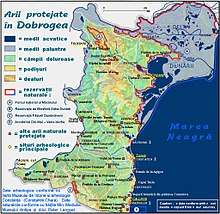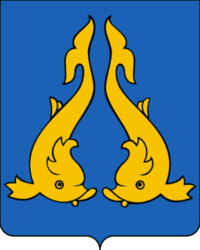Northern Dobruja
Northern Dobruja (Romanian: Dobrogea; Bulgarian: Северна Добруджа, Severna Dobrudzha) is the part of Dobruja within the borders of Romania. It lies between the lower Danube river and the Black Sea, bordered in the south by Southern Dobruja, which is part of Bulgaria.

History

Around 600 BC, the Greeks colonized the Black Sea shore and founded numerous fortresses: Tomis (today's Constanta), Callatis, Histria, Argamum, Heracleea, Aegysus. After Greek civilization faded, Dobruja became a Roman province. One of the best preserved remnants of this period is the Enisala citadel.[1]
Between the 7th and 14th century, Dobruja was part of the First Bulgarian Empire and the Second Bulgarian Empire.
For a short period in the 14th century, Dobruja became part of Wallachia under the rule of voivode Mircea the Elder. However, the territory fell under Ottoman rule from the mid-15th century until 1878, when it was awarded to Romania for its role in the 1877-78 Russo-Turkish War, and as compensation for the transfer of a region partly overlapping the South Bessarabia.[2] Under the treaties of San Stefano and Berlin, Romania received Northern Dobruja while the newly restored Principality of Bulgaria received the smaller southern part of the region. After the Second Balkan War in 1913, Romania also annexed the Bulgarian Southern Dobruja, which it ruled until the signing of the 1940 Treaty of Craiova. The treaty was approved by Britain,[3] Vichy France, Germany, Italy, the Soviet Union and the United States.[4]
Geography
The territory of Northern Dobruja now forms the counties of Constanța and Tulcea, with a total area of 15,570 km² and a current population of slightly under 900,000.[5]
Rivers
- Casimcea
- Slava
- Taița
- Telița
Lakes
- Crapina Lake
- Jijiei Lake
- Traian Lake
- Babadag Lake
- Razim Lake
- Zmeica Lake
- Sinoe Lake
- Tașaul Lake
- Techirghiol Lake
Danube Delta
The Danube Delta consists of numerous lakes. The most important ones are:
- Roșu
- Isac
- Gorgova
- Furtuna
- Ledeanca
- Tatanir
- Merhel
- Matița
- Uzlina
- Dranov
- Lumina
- Puiu
- Puiuleț
Demographics
| Ethnicity | 1878[6] | 1880[7] | 1899[7] | 1913[8] | 19301[9] | 1956[10] | 1966[10] | 1977[10] | 1992[10] | 2002[10] | 2011[5] |
|---|---|---|---|---|---|---|---|---|---|---|---|
| All | 225,692 | 139,671 | 258,242 | 380,430 | 437,131 | 593,659 | 702,461 | 863,348 | 1,019,766 | 971,643 | 897,165 |
| Romanian | 46,504 (21%) | 43,671 (31%) | 118,919 (46%) | 216,425 (56.8%) | 282,844 (64.7%) | 514,331 (86.6%) | 622,996 (88.7%) | 784,934 (90.9%) | 926,608 (90.8%) | 883,620 (90.9%) | 751,250 (83.7%) |
| Bulgarian | 30,177 (13,3%) | 24,915 (17%) | 38,439 (14%) | 51,149 (13.4%) | 42,070 (9.6%) | 749 (0.13%) | 524 (0.07%) | 415 (0.05%) | 311 (0.03%) | 135 (0.01%) | 58 (0.01%) |
| Turkish | 48,783 (21,6%) | 18,624 (13%) | 12,146 (4%) | 20,092 (5.3%) | 21,748 (5%) | 11,994 (2%) | 16,209 (2.3%) | 21,666 (2.5%) | 27,685 (2.7%) | 27,580 (2.8%) | 22,500 (2.5%) |
| Tatar | 71,146 (31,5%) | 29,476 (21%) | 28,670 (11%) | 21,350 (5.6%) | 15,546 (3.6%) | 20,239 (3.4%) | 21,939 (3.1%) | 22,875 (2.65%) | 24,185 (2.4%) | 23,409 (2.4%) | 19,720 (2.2%) |
| Russian-Lipovan | 12,748 (5,6%) | 8,250 (6%) | 12,801 (5%) | 35,859 (9.4%) | 26,210 (6%)² | 29,944 (5%) | 30,509 (4.35%) | 24,098 (2.8%) | 26,154 (2.6%) | 21,623 (2.2%) | 13,910 (1.6%) |
| Ruthenian (Ukrainian from 1956) |
455 (0.3%) | 13,680 (5%) | 33 (0.01%) | 7,025 (1.18%) | 5,154 (0.73%) | 2,639 (0.3%) | 4,101 (0.4%) | 1,465 (0.1%) | 1,177 (0.1%) | ||
| Germans | 1,134 (0,5%) | 2,461 (1.7%) | 8,566 (3%) | 7,697 (2%) | 12,023 (2.75%) | 735 (0.12%) | 599 (0.09%) | 648 (0.08%) | 677 (0.07%) | 398 (0.04%) | 166 (0.02%) |
| Greek | 3,480 (1,6%) | 4,015 (2.8%) | 8,445 (3%) | 9,999 (2.6%) | 7,743 (1.8%) | 1,399 (0.24%) | 908 (0.13%) | 635 (0.07%) | 1,230 (0.12%) | 2,270 (0.23%) | 1,447 (0.16%) |
| Roma | 702 (0.5%) | 2,252 (0.87%) | 3,263 (0.9%) | 3,831 (0.88%) | 1,176 (0.2%) | 378 (0.05%) | 2,565 (0.3%) | 5,983 (0.59%) | 8,295 (0.85%) | 11,977 (1.3%) |
- 1According to the 1926–1938 Romanian administrative division (counties of Constanța and Tulcea), which excluded a part of today's Romania (chiefly the communes of Ostrov and Lipnița, now part of Constanța County) and included a part of today's Bulgaria (parts of General Toshevo and Krushari municipalities)
- 2Only Russians. (Russians and Lipovans counted separately)
Symbols

Northern Dobruja is represented by two dolphins in the Coat of arms of Romania.
Starting with 2015, Romania observes Dobruja Day on November 14, marking the 1878 incorporation of Northern Dobruja into the Kingdom of Romania after the Treaty of Berlin.[11]
References
- Dobrogea fortresses and history
- Woolf, Stuart Joseph (December 21, 1995). Nationalism in Europe, 1815 to the present: a reader. Routledge. p. 115. ISBN 978-0-415-12563-5.
- The New York Times, July 26, 1940, "Britain recognizes the "fundamental justice" of Bulgaria's claim against Rumania for return of the wheat-growing section of Southern Dobruja"
- Кузманова, Антонина. От Ньой до Крайова. Въпросът за Южна Добруджа в международните отношения /1919-1940/, София 1989, с. 287-288.
- 2011 census results per county, cities and towns "Populația stabilă pe sexe, după etnie – categorii de localități, macroregiuni, regiuni de dezvoltare și județe" (XLS) (in Romanian). Institutul Național de Statistică. Retrieved 2015-11-20.
- K. Karpat, : Correspondance Politique des Consuls. Turguie (Tulqa). 1 (1878) 280-82
- G. Dănescu, Dobrogea (La Dobroudja). Étude de Géographie physique et ethnographique
- Roman, I. N. (1919). "La population de la Dobrogea. D'apres le recensement du 1er janvier 1913". In Demetrescu, A (ed.). La Dobrogea Roumaine. Études et documents (in French). Bucarest. OCLC 80634772.
- Calculated from results of the 1930 census per county, taken from Mănuilă, Sabin (1939). La Population de la Dobroudja (in French). Bucarest: Institut Central de Statistique. OCLC 1983592.
- Calculated from statistics for the counties of Tulcea and Constanța from "Populația după etnie la recensămintele din perioada 1930–2002, pe judete" (PDF) (in Romanian). Guvernul României — Agenția Națională pentru Romi. pp. 5–6, 13–14. Retrieved 2007-05-02.
- "The Law No. 230/2015 regarding the Declaration of November 14 as Dobruja Day" (in Romanian). Monitorul Oficial. 6 October 2015.